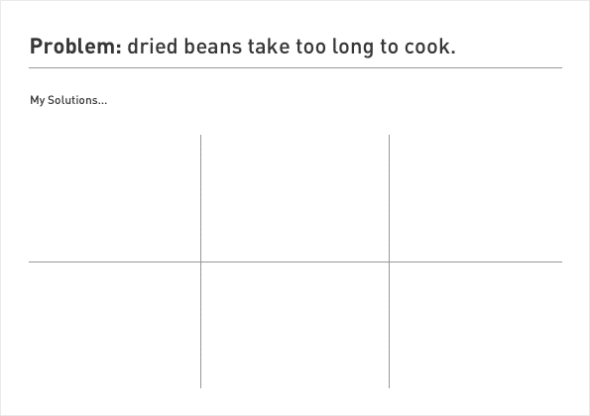You’ve identified a problem and maybe even asked, “How might we…?” Now it’s time to think of some fast solutions. 2×3 can kickstart quick prototyping and ideation. It’s great as a warmup for more detailed or complex solution-building activities.
This is part of our series on Design Thinking Methods and Activities. You’ll find a full list of posts at the end of this page.
| Primary Goal | To quickly sketch potential solutions to a problem |
| When to Use | As a precursor to detailed solution-exploring activities |
| Time Required | 20-40 minutes |
| Number of Participants | 1-10+ |
| Who Should Participate? | Any members of the team |
| Supplies | A problem statement, Sharpies, and an activity template |
Let’s say you have a few problem statements but aren’t quite ready to dive into complex wireframing, sketching, or prototyping exercises yet. You just want a quick way to knock out top-of-mind solutions that can be used as tinder for deeper brainstorming sessions. 2×3 will help you light that fire!
To begin this activity, you’ll need a problem or a “How might we…” statement. Here are some examples:
- How might we connect with our community?
- How might we encourage more people to sign up?
- Problem: Dried beans take too long to cook.
- Problem: Donating blood is inconvenient.
- Problem: Our community has no grocery stores in a 20-mile radius.
For this post, we’ll use the problem statement “Dried beans take too long to cook.”
1. Prep Your Materials
First, create your grid template. You can have templates ready-made, or you can have participants sketch a 2×3 grid on a piece of paper or whiteboard. At the top of the grid, write your problem statement.

This template is purposefully simple. The simpler the setup, the more valuable this activity becomes, as this is truly about the speed of thought to paper.
As an alternative to a grid, participants could also sketch six ideas on Post-it notes (one idea per note).
2. Run the Activity!
Give each participant a worksheet and a Sharpie. Explain that they should sketch one potential solution per block. Encourage both practical and crazy ideas. Nothing is off limits with this activity. In fact, if the group is in high spirits, you could host multiple rounds, depending on how quickly ideas are created.
Set a timer for five minutes, then start the activity. Keep an eye out, though. You may want to tack on a few minutes if participants take a while to fill out their grids entirely.
Once time runs out, have participants share their solutions one by one. No idea is too far-fetched or wild at this point. Sometimes wacky ideas can trigger practical ones, so be sure to nurture “Yes, and…” language during this time. This activity is about producing a quantity of ideas.
3. Next Steps
If your group has produced many different ideas, take this opportunity to post everyone’s solutions on the wall and Visualize the Vote by giving each participant four or five dot stickers and having them vote on their favorite solutions. The three solutions with the most votes can be used as a basis for future rounds of prototyping and iteration.
Sketch on! And let us know in the comments if you’ve tried 2×3 before.
Atomic’s Design Thinking Toolkit
- What Is Design Thinking?
- Your Design Thinking Supply List
- Activity 1 – The Love/Breakup Letter
- Activity 2 – Story Mapping
- Activity 3 – P.O.E.M.S.
- Activity 4 – Start Your Day
- Activity 5 – Remember the Future
- Activity 6 – Card Sorting
- Activity 7 – Competitors/Complementors Map
- Activity 8 – Difficulty & Importance Matrix
- Activity 9 – Rose, Bud, Thorn
- Activity 10 – Affinity Mapping
- Activity 11 – Speed Boat
- Activity 12 – Visualize The Vote
- Activity 13 – Hopes & Fears
- Activity 14 – I Like, I Wish, What If
- Activity 15 – How to Make Toast
- Activity 16 – How Might We…?
- Activity 17 – Alter Egos
- Activity 18 – What’s On Your Radar?
- Activity 19 – The Perfect Morning
- Activity 20 – 2×3
- Activity 21 – How Can I Help…?
- Activity 22 – Cover Story
- Activity 23 – Crazy 8s
- Activity 24 – Abstraction Ladder
- Activity 25 – Empathy Map
- Activity 26 – Worse Possible Idea
- Activity 27 – Pre-Project Survey
- Activity 28 – The Powers of Ten
- Activity 29 – SCAMPER
- Activity 30 – Design Studio
- Activity 31 – Forced Connections
This is an updated version of a post originally published in May 2020.

